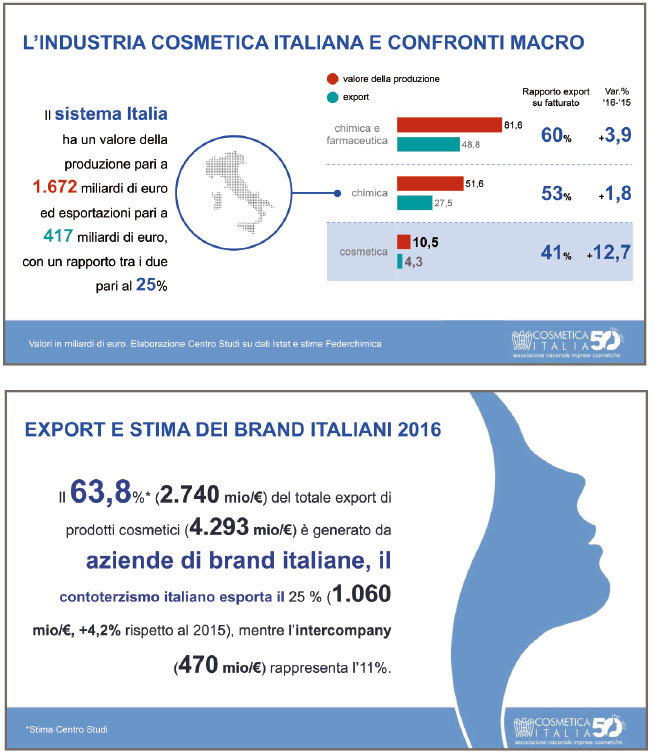Cosmetics: strong performance and positive trends
According to estimates, the Italian cosmetics sector will see a 2017 turnover totaling nearly 11 billion euro, with unstoppable growth for exports. In distribution, specialized shops, single brand and e-commerce are showing excellent performance, with broad consensus among consumers. Data and facts presented by Cosmetica Italia in Milan on 25 July.

The findings of Cosmetica Italia’s economic survey for the year 2017 confirms the growth of the cosmetic sector’s overall turnover. While in 2016 that value was 10.5 billion euro, forecasts for 2017 are approaching 11 billion (+1.2%). Exports continue to have a positive impact, with an estimated growth of 9.5% from now through to the end of the year (4,800 million euro).
As Cosmetica Italia president Fabio Rossello was careful to stress during opening remarks at a conference to present the economic survey, «With the macro-economic outlook still uncertain for the Italian economy, the national cosmetic industry has confirmed its competitiveness by continuing with investments in innovation, research and expanding its output capacity in order to maintain the leadership position on international markets that it has gained thanks to the quality and safety of its offer».

Market characteristics
Marked by profound changes in consumer habits, the cosmetic market has confirmed itself as recession-proof in recent years. In late 2017, according to the analysis carried out during the summer, the value of cosmetics purchased in Italy will have reached 10,000 million euros for the year, representing growth of just over one percentage point, while volumes have seen a predictable and generalized decline.
The economic survey reveals substantial differences among the various distribution channels.
Renewed interest in service and well-being have led to the recovery of sales through professional channels (hairstylists and beauty salons) during recent months, and this channel is expected to finish the year with close to +2%.
Large retail chains, on the other hand, have been driven by single brand products and special areas dedicated to home/personal care products, seeing upwards of 6% growth.
E-commerce is also showing strong performance, significantly impacting direct sales, which are expected to see 8.5% growth. In 2017, the value of online sales alone approaches 300 million euro due to the entry of new players.
In 2017, Cosmetica Italia’s research center conducted a study of “natural” cosmetics.
The findings showed that green cosmetics generated 950 million euro, 9% of the sector total. Preliminary data on the first half of 2017 shows modest growth for herbal shops (+0.8%) and pharmacies (+0.5%) and a slight drop for perfume shops (0.5%).
Finally, the positive trend of contractor businesses continues as they position themselves upstream and across sectors to service other channels. Contractors reached +5% growth during the first half of 2017, and further growth is expected for the latter part of the year.

Scenarios for future
During the July conference, Giacomo Fusina (founder of Human Highway) provided a “glance” at 2027 in Italian cosmetics.
Targets and forecasts for the sector are at the heart of research conducted by that company at the behest of Cosmetica Italia, analyzing supply and demand in relation to consumption volumes, product developments, new ways of buying, and social, commercial and value trends by interviewing 1,600 beauty product consumers and 58 concerns belonging to the association.
Fusina offered insightful points for reflection, a brief summary of which follows.
Forecasts. While the two target groups largely agree on a projected increase in consumption, they diverge when describing the cosmetics of the future.
The common key words “innovative”, “effective” and “natural” notwithstanding, consumers expect increasingly organic, affordable and ecological products, while operators tend to focus more on safety and product life cycle. And what is expected of packaging? For consumers, first and foremost that it be practical and recyclable, as well as compact, colorful, attractive, always with the possibility of refills, in standard formats and monodose, and with incorporated diagnostic tools.
Operators, with a firm conviction in technological advances, imagine increasingly intelligent packaging (integrated QR codes) and materials that offer maximum protection of the product. In a word, they are focused on functionality.

The survey also investigated how cosmetics are purchased and where (both on the street and online): 3 out of every 10 consumers say that in 10 years they will be buying primarily online and only occasionally at traditional retail shops.
Almost the same proportion (27.6%) believe that they will still be buying from traditional shops in a decade from now.
The largest share is made up of multi-channel consumers, who imagine using both, on and off, with the same frequency.
Business and consumers have rather different ideas as to the development of digital technologies as an auxiliary to sales in the 2027 store, as well as on how the shopping experience will evolve.
While the industry is focused on process efficiency (real-time trend monitoring, automatic payments, tutorials, etc.), consumers prefer to use technology to seek advice, services and personalized products.
In conclusion, the future of the cosmetic industry – in order to valorize Made in Italy and compete on the global market – will be guaranteed by its capacity for accommodating numerous ethical, social and environmental demands, in which the umbrella term “sustainability” means ecology, circular economy, responsible use of resources and care for the individual.

















